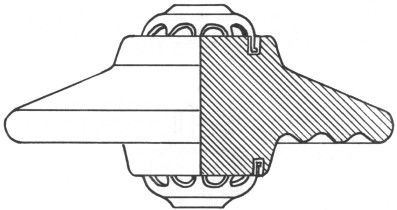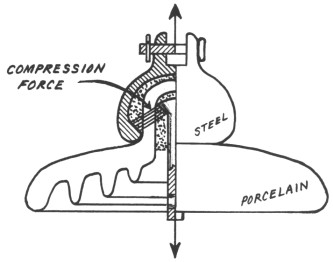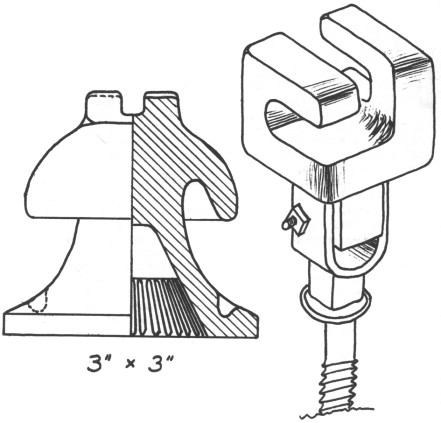Porcelain Insulator News
by Jack H. Tod, NIA #13
Reprinted from "INSULATORS - Crown Jewels of the Wire", April 1982, page 5
Dear Jack:
I recently acquired at
an auction two very bulky and crudely constructed suspension insulators (see
below). The glaze is grey with streaks of blue, and there are no markings to
identify the manufacturer.
When I first saw these in a crate, the first thing I
noticed was the odd metal fixtures on the top and bottom. These 8- prong spiders
are leaded into holes in the disk.
Any information you could provide about these
insulator would be greatly appreciated -- how they were used, identity of the
manufacturer, whether they're considered scarce.
Steven Kella
2501 Shettler Rd.
Muskegon, Mich. 49444

- - - - - - - - -
I've received about two dozen queries on these in the
past ten years. We've run the answer in CJ before, but I guess a repeat answer
here might be helpful.
Dear Steven:
The suspension insulators you have are meant
to be used in the customary fashion -- assembled in strings to achieve the
desired degree of insulation for transmission lines.
These particular ones were
made by the Jeffery-Dewitt Insulator Co., Kenova, WV. Their standard glaze color
on suspension insulators and all pin types rated over 23 Kv was this "J-D
blue" glaze.
This company was established in 1915, mainly on the basis of
making this patented style of suspension insulator disk. These and other high
voltage insulators were made by them by the casting process. The design is a
horrible one, since the disks are inherently operated with the porcelain in
tension, as opposed to the conventional cap-and-pin type of suspensions which
place the porcelain in compression under load.
Not too many years after these
were in wide use, they began to fail in alarming numbers, and the industry
replaced them wholesale fashion with established designs which had been proven
reliable. This event was nearly the undoing of the company in one swoop, but it
struggled along until finally closing down in the 1940's.
Most (but not all) of
the J-D high voltage insulators are marked with the manufacturing date such as
"Mfg Aug 17 1931". Even without a marking, they are identifiable
because of this really oddball design, plus the characteristic glaze color.
These J-D suspensions are not scarce in collector circles, many having been
saved just because they were so unusual.
Now, in case any of you are wondering
how the porcelain in a conventional suspension insulator design is operated in
compression when the top cap is pulled up and the bottom pin pulled down, see
the sectioned view below. The pressure surfaces of the overlapping cap and pin
create a compressive force between each other when the insulator is weight
loaded. Even if the entire radiating porcelain shell is broken away, the
insulator will not fail mechanically.
Jack

NEW PORCELAIN BOOK
Collector's Guide
to Pricing Porcelain Insulators, by David Bethman 1982, softbound, 8-1/2"
x 11" , 50 pages, $6 plus $.63 shipping -- from the author at 3307 Bennett
Drive, Bellingham, WA 98225.
This is the first comprehensive and easy-to-use
pricing guide ever published for porcelain pin types. It contains 1240
"line" items listed by style (U- number), marking, glaze color and
value. An additional column serves as a checklist feature, and the left-hand
facing pages are unprinted so they can be used for making notes on your
particular specimens.
The frontal text material also includes eight pages for a
compact summary of all the markings used on porcelain pin types -- a super handy
tool for any beginner or intermediate collector not instantly familiar with all
the many markings he will encounter.
The price listing covers so many specific
insulators that virtually any insulator you will ever encounter will be shown
there. For the sake of practicality, the list excludes the many very common
styles with common markings and common glazes, all of which are usually valued
at $1 or less each.
I have spent considerable time studying the prices shown in
the book and found them to be remarkably accurate throughout the list. The
pricing level is middle-of-the-road for sticker prices you would see at any
current large insulator show or on sell lists of active collectors. I highly
recommend this book be obtained by all collectors -- from the beginners to
advanced. I would put it on the absolute "must" list for any collector
or dealer who buys or sells porcelain pin types, even occasionally.
Jack

Ref
page 21 of the July 1976 issue of CJ, John Hall (Ohio) stated that the
Bennington museum in Bennington, Vermont had on display several styles of
porcelain insulators formerly made by the Bennington Company, but that these
were ordinary styles of threaded pin types.
We have spent so much time trying to
establish whether or not Bennington made the old threadless items that the
impact of John's revelation must have been lost in the shuffle. It would be
extremely revealing and important to know what specific insulators they did
allegedly make!
So I now repeat my 1976 appeal that some eastern collector visit Bennington to determine the U- numbers and identifying characteristics of those
specimens. This would be really super info -- worth two gold stars.
Jack

Dear
Jack:
I can't seem to be able to find any information on these two insulators (above). Could you please let me know what your know about their rarity, origin,
value, etc.?
Rex M. Vaughn, NIA #520
Anderson, California
- - - - - - - - - - -
Dear Rex:
The large
insulator with lag screw mount is a slack-wire tree insulator cataloged and sold
by Line Material Co., and the L-M marking appears on the porcelain part of it.
The recess-embossed "U" marking on the porcelain part indicates that
was made for L-M by Universal Clay Products Co., Sandusky, Ohio.
Interestingly,
the designers of the porcelain part made a gigantic goof. The catalog says to
install it, you screw it into the tree with the top groove ending horizontal,
insert the wire, then wrench the screw a half turn to the right to lock in the
wire. But the ears on the porcelain point in the direction which require a half
turn to the left to lock the wire -- a poorer arrangement.
For other physical
mounting arrangements, the porcelain can be oriented 90 degrees differently in
the steel yoke.
Your little black insulator (also comes in brown) shows up every
once in awhile in collector circles. As far as I know, it's still a
"whatisit" -- which is a much classier name than "gismo".
Gerald Brown shows this item on page 132 of his 2nd Edition and repeats without
comment the hearsay info (guesses?) that it was an "attic insulator"
or possibly used in neon sign installation.
We would appreciate hearing from any
CJ reader who knows for sure the intended use of this gadget, insulator or
otherwise. Wild guesses won't count.
Jack
FOREIGN PORCELAIN INSULATOR BOOK
Here's advance information on this book being coauthored by Marilyn Albers
(Houston) and this writer.
We have been frantically working on this book since
last summer and thus far have made over 300 of the scale drawings for its style
chart -- about 3/4 of the drawings that will be made for the initial edition to
be available early this summer. As with all previous insulator reference books,
the idea is to somewhere draw the line and publish the information at hand as a
starting point. Then, anything not shown in the book can be considered new and
needed material.
The book will be similar in format to the familiar
"Porcelain Insulators Guide Book" on U.S. insulators -- the frontal
material explaining the foreign practices and the special insulator designs and
uses etc., followed by the complete style chart of all foreign porcelain pin
types, then the information on all known manufacturers and markings attributed
to each one. As with the 1981 book on foreign glass insulators by Marilyn, this
one will have an appendix tabulation of all styles showing what manufacturers
and markings are known for each one.
Since we let the cat out of the bag some
time ago about the pending publication of this book, it's evident a number of
collectors are champing at the bit for it to appear. Be patient; it won't be
long now. Before even this first edition is done, I estimate Marilyn and I will
have spent over 1400 people-hours on it, plus some considerable expense for all
involved in its making. If even 200 people end up using the book, that means
we've spent 7 hours working on it for each one who'll benefit from it. A labor
of love?
Jack

Dear Jack:
... and I also found this small aqua glass insulator
while digging for insulators and bottles in the old city dump here at Starke. It
appears to be some sort of a bushing. Do you know what it is?
Malcolm Sanders,
NIA #1567
Starke, Florida
- - - - - - - - - -
Dear Malcolm:
This insulator is for lightning rods --
and I presume to insulate the conducting rod from the metal mounting stand. This
and very similar versions were also made by a number of porcelain companies. As
lightning rods and accessories are, these bushings are collector items.
Jack

Dear Jack:
In your book you state that the U-239 embossed Thomas is not common.
I have a few of these which are very crude dry process and no doubt old. Of
interest here though is the fact that on the line where I got these, the
embossed ones are not common, but each pole has at least two insulators which
look like they came from the same mold (same glaze too) and yet are not marked.
Could these also be Thomas, Incidentally, what would be a fair value for the
embossed ones?
Emory Snyder
White Haven, PA
- - - - - - - - - - -
Dear Emory:
The appeal of the Thomas
U-239 and U-294A with the embossed (raised) markings is mainly that, other than
older O-B wet process items, embossed markings exist on only several items. One
case is these Thomas items, and the other is the MACOMB marking found on the
early Illinois dry process items. Add to this the facts that these Thomas items
are scarce items, they were made in the 1907-1920 period and represent the very
few styles ever made dry process by Thomas. I'd guess that either of these
Thomas items would be $5 items but I think the U-239 is the most common of the
two styles.
You're probably correct that the very similar ones unmarked are also
Thomas. That characteristic crown with the long, arched smoothing marks exists
on ponies, exchanges and transpositions. All these telephone styles are quite
similar as to glaze and fabrication details, so we've long regarded them as
Thomas because of the ones such as yours which are marked THOMAS.
Jack
| 